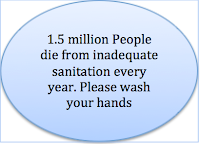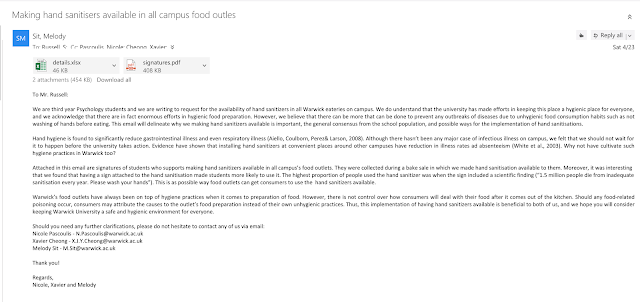It’s a basic hygiene practice that you will probably ignore because the washroom is simply too far away from the cafe till. So we decided to make it more convenient for you, and push for a petition to place hand sanitisers in all eateries within the Warwick Campus.Why hand sanitisation is important:Hand hygiene is found to significantly reduce gastrointestinal illness and even respiratory illness (Aiello, Coulborn, Peres & Larson, 2008). Although there hasn’t been any major case of infectious illness on campus, we felt that we should not wait for it to happen before the university take action. Evidence has shown that placing hand sanitisers at convenient places around school campuses have reduced illness rates and absenteeism (White et al., 2003). So why not cultivate such hygiene practices in Warwick too?How we did it:In order to see the effectiveness of adding a hand sanitiser to food outlets, we hosted a bake sale (raising money for Breast Cancer Now and Coppafeel). We got people to come to our bake sale via Facebook: And what we made for our bake sale:
And what we made for our bake sale: A hand sanitiser was placed on the table alongside the food and it was free for anyone to use. This will serve as a platform for us to ask for their support in signing the petition for making hand sanitisers available in all Warwick food outlets. In a bid to get people to notice and use the hand sanitisers (technique: availability heuristics/salience), we attached signs to the hand sanitisers, which we alternate from time to time in order to see which type of sign would be the ost effective at changing participants behaviour.Sign 1: No sign attached (Control)Sign 2: Salience
A hand sanitiser was placed on the table alongside the food and it was free for anyone to use. This will serve as a platform for us to ask for their support in signing the petition for making hand sanitisers available in all Warwick food outlets. In a bid to get people to notice and use the hand sanitisers (technique: availability heuristics/salience), we attached signs to the hand sanitisers, which we alternate from time to time in order to see which type of sign would be the ost effective at changing participants behaviour.Sign 1: No sign attached (Control)Sign 2: Salience Sign 3: Informative
Sign 3: Informative We used the door-in-the-face technique to get them to sign the petition. For those who used the hand sanitisers, we thank them for using it. We then proceed with the first request: we asked them whether they would be willing to become an ambassador for Warwick hygiene (fictional), which requires training every month for a year. Our second request was to have them sign a petition now for making hand sanitisers available in all campus eateries. Results:We found that when there was no sign attached to the hand sanitiser, only 10% of those who approached our till used it. However, when the hand sanitiser was attached with an inviting sign (sign 2), 45% of those approached used it. It further increased to 75% when the sign was informative (sign 3). As expected, no one was willing to accept the first request of becoming a hygiene ambassador citing busy schedules. They all agreed to the second request of signing the petition. Petition:
We used the door-in-the-face technique to get them to sign the petition. For those who used the hand sanitisers, we thank them for using it. We then proceed with the first request: we asked them whether they would be willing to become an ambassador for Warwick hygiene (fictional), which requires training every month for a year. Our second request was to have them sign a petition now for making hand sanitisers available in all campus eateries. Results:We found that when there was no sign attached to the hand sanitiser, only 10% of those who approached our till used it. However, when the hand sanitiser was attached with an inviting sign (sign 2), 45% of those approached used it. It further increased to 75% when the sign was informative (sign 3). As expected, no one was willing to accept the first request of becoming a hygiene ambassador citing busy schedules. They all agreed to the second request of signing the petition. Petition: Signatures:
Signatures: Due to confidentiality purposes, student details of those who signed are not posted up here on the blog. However, we have included them to our email to the commercial operations director as proof that the signatures are by university staff and students. We also filled in a “start a campaign” form on the su website. Here is the email we sent to the commercial operations director:
Due to confidentiality purposes, student details of those who signed are not posted up here on the blog. However, we have included them to our email to the commercial operations director as proof that the signatures are by university staff and students. We also filled in a “start a campaign” form on the su website. Here is the email we sent to the commercial operations director: ** Update as of 28 April 2016:We have received an email back from the Campaign Coordinator who informed us he has taken action to introduce hand sanitisers in SU-owned food outlets!
** Update as of 28 April 2016:We have received an email back from the Campaign Coordinator who informed us he has taken action to introduce hand sanitisers in SU-owned food outlets! And true enough, here’s one from Xananas:
And true enough, here’s one from Xananas: Although they had their reasons not to place the informative sign we suggested, they were willing to put on this inviting sign.You can now have clean hands to eat on campus now!- Nicole Pascoulis- Melody Sit- Xavier CheongReferences:Aiello, A.E., Coulborn, R.M., Perez, V.P., & Larson, E.L. (2008). Effect of hand hygiene on infectious deisease risk in the community setting: A meta-analysis, American Journal of Public Health, 98(8), 1372-1381.Jónsdóttir, H.L., Holm, J.E., Poltavski, D., & Vogeltanz-Holm, N. (2014) The role of fear and disgust in predicting the effectiveness of television advertisments that graphically depict the health harms of smoking, Preventing Chronic Disease, 11.White, C., Kolble, R., Carlson, R., Lipson, N., Dolan, M. Ali, Y., Cline, M. (2003). The effect offhand hygiene on illness rate among students in university residence halls, American Journal Of Infection Control, 31(6), 364-370
Although they had their reasons not to place the informative sign we suggested, they were willing to put on this inviting sign.You can now have clean hands to eat on campus now!- Nicole Pascoulis- Melody Sit- Xavier CheongReferences:Aiello, A.E., Coulborn, R.M., Perez, V.P., & Larson, E.L. (2008). Effect of hand hygiene on infectious deisease risk in the community setting: A meta-analysis, American Journal of Public Health, 98(8), 1372-1381.Jónsdóttir, H.L., Holm, J.E., Poltavski, D., & Vogeltanz-Holm, N. (2014) The role of fear and disgust in predicting the effectiveness of television advertisments that graphically depict the health harms of smoking, Preventing Chronic Disease, 11.White, C., Kolble, R., Carlson, R., Lipson, N., Dolan, M. Ali, Y., Cline, M. (2003). The effect offhand hygiene on illness rate among students in university residence halls, American Journal Of Infection Control, 31(6), 364-370